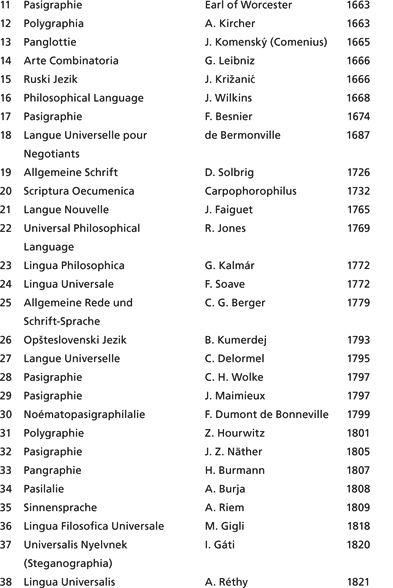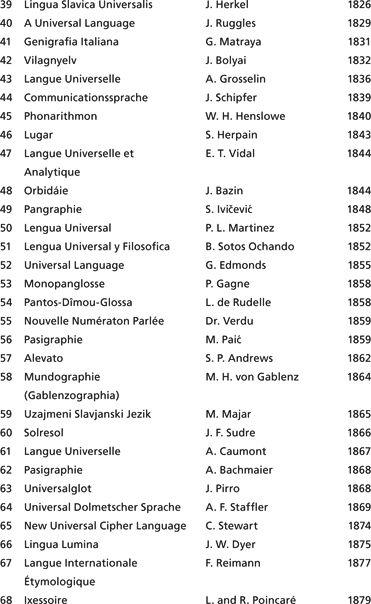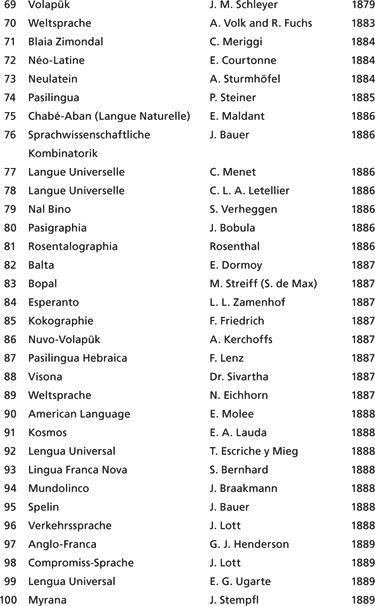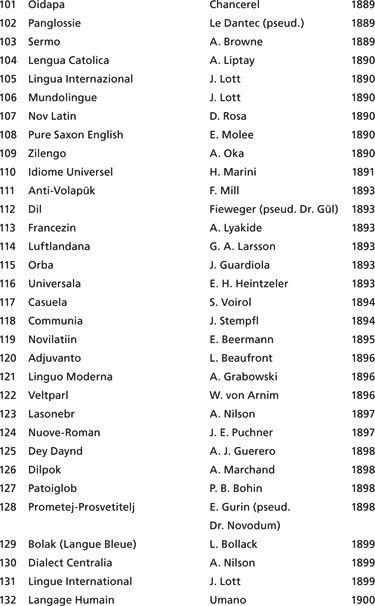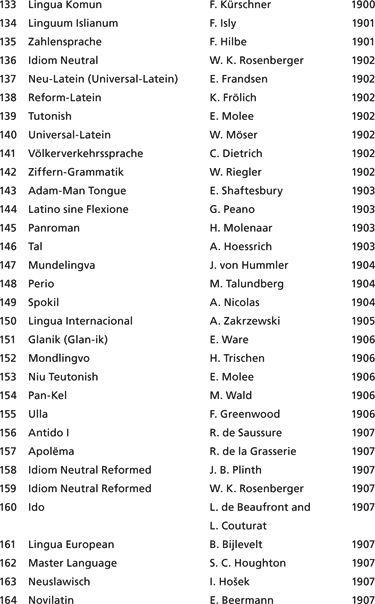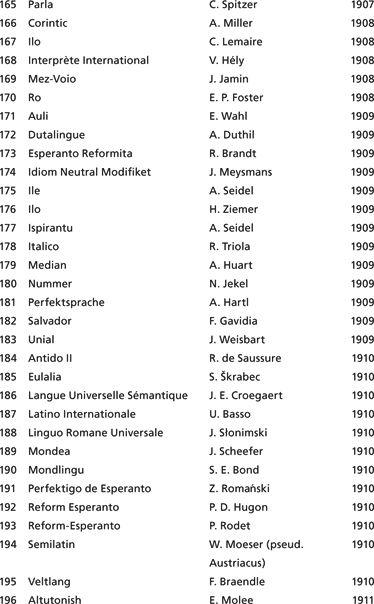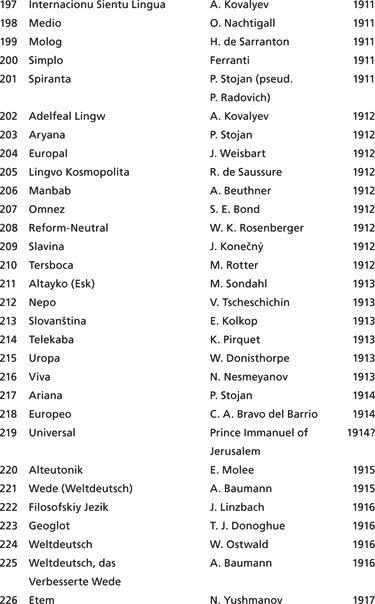In the Land of INVENTED LANGUAGES (38 page)
Read In the Land of INVENTED LANGUAGES Online
Authors: Arika Okrent

In this atmosphere of lively exchange and discussion, some critical standards have emerged. Languages that are too Englishy are frowned upon, as are “kitchen sink” languages or “Frankenlangs,”
which just throw together every cool feature the author can think of but don't make sense as a whole. First timers often make the mistake of excitedly trumpeting a great new idea for marking pronouns, or negating sentences, or indicating tense, only to be patiently referred to the hundreds of natural languages that already do it that way. It is much harder to come up with something original than one might think. And while originality is appreciated, it must be backed up by complexity and depth. The most respected languages in the conlang community often have years of work behind them, and may even be attached to whole “conworlds” or “concultures” that help give them coherence and a model “literature.”
It is clear that the upper-echelon active conlangers have a lot of knowledge about a wide range of natural languages. Many critiques of proposed conlang features branch off into lengthy dis-cussions about exotic Australian languages or the sound-change rules of ancient Greek. In the summer of 2007, I attended the second annual Language Creation Conference in Berkeley, where about forty conlangers gathered to give presentations, participate in workshops, and socialize. The technical level of the discussions was sometimes incredibly high; people really knew their stuff. When one presenter began by playing some sound files and asking the audience to guess which languages they were, someone guessed right every time—Breton, Finnish, Navajo.
For these language inventors, language was not an enemy to be tamed or reformed but a muse. And they bowed down before her. Jeff Burke, a tall man who seemed nervous and shy at the podium, explained how he had been inspired to build his own family of “Central Mountain” languages by the incredible beauty he found in Mohawk when he took a course on it in college. He said the language “did something to me,” and he began to dig
into the history of the language, becoming a self-taught expert in the development of Mohawk from Proto-Iroquoian. He was also fascinated by Cheyenne and wanted to capture “the spirit of its sounds,” so he studied the development of the language from Proto-Algonquian. His talk didn't focus so much on his own creation as on the real languages that inspired it. He wanted us to understand where his artistic vision had come from. As he went over the complicated details of the Mohawk pronominal system, he spoke softly, but with such love and wonder in his voice that I thought he might burst into tears.
I was energized by the proceedings, reminded of the reason I had gone into linguistics in the first place—my own heart-fluttering fascination with languages. Over the years that visceral feeling had been somewhat dampened by the intellectual focus that an academic track demands. All linguists begin with that spark of love for language, but they sometimes end up so involved in supporting a theory or gathering evidence against someone else's theory that they forget it. Languages become cold bundles of data that they pick through for what they need. There is value in this kind of activity, and sometimes excitement as well, but it rarely inspires delight.
And there was plenty of delight at the conlang conference. One of the most popular presentations was by Don Boozer, a librarian at the Cleveland Public Library. His language, Dritok, was born when he began to wonder if it was possible to make a language out of chipmunk noises. He started constructing a voiceless language, carried solely by clicking, popping, and hissing sounds. The loudest sound in the language (used for pejoratives) is a sort of forceful pig snort. The examples he gave sent waves of glee through the audience—they sounded so strange, so inhuman, but there was a detectable structure or system that
gave Dritok a scent of “languageness.” He had also worked out aspects of a cultural context that would help the language make sense. Dritok is the language of the Drushek, long-tailed beings with large ears and no vocal cords who value solitude and quiet. They also use gestures for some syntactic functions. People immediately started asking questions: “How do they yell?” “Do they make art?” “Can they use whistling?” “Can they throw objects to get someone's attention?” “Do they have thick skin?” Boozer hadn't yet worked things out that far, but it was clear that if he wanted to, he had the blessings of the conlang community. They were clamoring for more.
Watching the presentations at the conlang conference got me thinking that I might like to make a language of my own. I came up with lots of ideas: a pan-conlang hybrid, formed from the features of various other invented languages; a language that used English words, but with different functions and meanings from those they have in English; a language whose phonemes were physical objects that had to be juggled in distinct patterns to make words; a language where every word is defined by its relationship to one specific concept; a language where the mesage has to be physically eaten and digested to be understood—immediacy of communication could not be a factor in that culture. I realized as I came up with these ideas that they were too “clever.” I had no desire to sit down and fill out the details of how any of them would work. I was moved not by the muse but by a desire to impress, to be seen as creative or original. I wanted to inspire that feeling of delight, to get the admiration and the respect that I had seen expressed for certain conlang projects, but I didn't want to do the work. I was that guy who wants to play guitar in order to get the girls, that woman who wants to write a novel so she can go to fancy New York cocktail parties. I wasn't
driven by a need to practice the art, to satisfy a personal vision; I just thought it would be cool for other people to think my language was cool.
I guess I don't have it in me. I'm not a language creation artist. But I
can
still be a language creation art appreciator, which itself takes a certain amount of work and background knowledge. The more you know about language and linguistics in general, the better you can enjoy the truly elegant or complex idea, and the better you can tell the good stuff from the lazy stuff, the mature solutions from the beginners' mistakes. One of the presenters, John Quijada (whose own language, Ithkuil, has been thirty years in the making and claims as its influences the “consonantal phonology and verbal morphology of Ubykh and Abkhaz, certain Amerindian verbal moods, Niger-Kordofanian aspectual systems, Basque and Dagestanian nominal case systems, Wakashan enclitic systems, the Tzeltal and Guugu Yimidhirr positional orientation systems, the Semitic triliteral root morphology, the evidential and possessive categories of Suzette Elgin's Láadan, and the schematic word-formation principles of Wilkins' Analytical Language and Sudre's Solresol”), compared the activities of the conlangers at the conference to a convention of biologists getting together to create an animal. “
They
would know and appreciate what they were doing, but it might be hard to explain to nonbiologists why some choices were praised as brilliant, some got a laugh, and others got a groan.”
At a very basic level, language invention is an expression of the creativity that is latent in all of us. Children like to draw pictures, playact scenes, and make up little tunes, and many of them also go through a phase where they experiment with sounds and invent their own words. When my son was two years old, he started saying, “
Goaji, goaji, goaji
,” with a strange Hindi sort of intonation, to represent “talking going on.” (He would say it when
he heard a foreign language—though he never heard Hindi—or when people were talking around him without paying attention to him.) I don't know why he settled on
goaji
except that it just felt right to him. This doesn't mean he is any more likely to grow up to be a language inventor than he is to continue his passion for coloring into adulthood, but the raw urge to create is there, as it is in everyone. As with painting, or music, or acting, only in some does that urge take root and blossom into a lifelong passion.
The language inventors of previous eras spent a lot of energy trying to convince others of the practical justifications for doing what they did. They had rational reasons for making their languages. But the artistic drive has always been there. In a recent book on Hildegard von Bingen's twelfth-century language, the medievalist Sarah Higley (herself an accomplished conlanger and science fiction author working under the pen name Sally Caves) argues that the purpose of Hildegard's language was personal expression, that she “looked upon her invention as a purer way than even Latin, Greek, or Hebrew to dignify and describe her world.” It wasn't, as some scholars have argued, a secret code for her nuns to use or the spontaneous product of a religious trance. It was the first published conlang.
You can see the art in the way John Weilgart, the creator of aUI, felt so sure that “ah” was the sound of space and “j” was the sound of evenness. Or in the way Johann Schleyer stubbornly clung to his beloved umlaut when the Volapük reformers argued that it hurt their international chances. It was there for Wilkins in his quest to make sense of the universe and order it accordingly, and for Suzette Elgin when she filled Láadan with her favorite natural-language features. It is even there in Esperanto, which Tolkien once praised for intuitively capturing the right balance between engineering and aesthetics. He criticized one of its competitors
for looking too much like a “factory product,” for seeming “made of spare parts” and being without the “gleam of the individuality, coherence and beauty, which appear in the great natural idioms, and which do appear to a considerable degree (probably as high a degree as is possible in an artificial idiom) in Esperanto—a proof of the genius of the original author.”
The artistry is obvious to the Esperantists, who tell stories, write poetry, and make jokes in what only they can fully appreciate as a quintessentially Esperanto way. It is there for the Lojbanists, one-upping each other by composing tongue twisters, riddles, and plays on words that work only in Lojban. It is there for the Klingon speakers, who put up with an awful lot of abuse in order to do what they love.
I finally ran out of time to study for my Klingon test. I went into the test feeling confident but weary. I was ready to go home. I needed to get back into the world and reassert my coolness.
First I had to endure the institute's business meeting, where at least thirty minutes was devoted to a discussion of whether the journal
HolQeD
should continue to be published in a print version in addition to the electronic version. (Pros: “It's neat to be archived at the Library of Congress.” “There's one on display at the Museum of Peace in Uzbekistan.” Cons: “It costs too much.” “It's redundant.”) “Who cares?” I grumbled under my breath from the back of the room, where I was flipping through my flash cards one last time.
Finally, the room cleared, leaving me, Louise, and a couple of other, more advanced test-takers. I dug in as soon as the test was laid in front of me, knowing my fragile web of mnemonics wouldn't last very long. I filled it out quickly. I couldn't remember
the word for “sergeant” (
bu'
) or the translation for
ngungu'
(identify), but otherwise I breezed through. I handed it in and went out to wait in the lobby with the rest of the
qep'a'
attendees while it was being graded.
I got a score of 93 points, well above passing. Everyone congratulated me and remarked on how well I did. My mood lifted. I felt proud. I looked around and saw, near the reception desk, a group of glossy-toothed “mundanes” checking in to the hotel. They appeared to be in town for a sales meeting, or maybe just the wedding of an old fraternity brother. They looked at us, immediately noticing, of course, a costumed member of our group. One of these so-called normal people walked right up to him and, without asking for permission, took out his cell phone to take a picture, saying to no one in particular, and certainly not to the Klingon in question, “If I don't get a picture of this, no one will believe me.” The Klingon stood up tall and posed like a true warrior. At that moment, I knew whose side I was on. The world of Klingon may be based in fiction, but living in it takes real guts.
Louise didn't pass the test. “Oh, well,” she said with a shrug and a smile. “I will try again next year.” And I was there the next year, at a highway hotel outside of Philadelphia, when she did pass the test. I bought her a drink, and we toasted to perseverance.
 The List of Languages
The List of LanguagesW
hat follows is a list of five hundred invented languages in chronological order. Why five hundred? Why not all of them? For one thing, no one knows how many there are. Any claim to completeness in a list would surely be undone by the discovery of yet another self-published book or pamphlet in a library storage room somewhere. Another problem is determining what should count as an invented language. Should a few lines of made-up gibberish in a novel earn a place on the list? What about a sketch of an idea with none of the detail filled in?
When I started assembling this list, I had the ambitious intention to be as complete as possible, to include every project that anyone anywhere had any evidence for, but this soon proved impractical. The story I was trying to tell got lost in a swamp of data. I wanted the list to be big enough to impress, to make
you exclaim, “I had no idea there were so many!” But I also wanted it to be manageable enough to serve as a sort of mini-history, where just by looking at the dates and the names of the languages, you could spot some general trends and get a sense of the connections between the ideas and the times.
I culled my list from the more than nine hundred languages covered in Aleksandr Dulichenko's
Mezhdunarodnye vspomogatel'nye iazyki
(International Auxiliary Languages, 1990). This massive piece of research includes all of the projects covered by previous overviews, such as
Histoire de la langue universelle
by Louis Couturat and Leopold Leau (1903),
Bibliografio de internacia lingvo
by Petr Stojan (1929),
Historio de la mondolingvo
by Ernest Drezen (1931), and
Précis d'interlinguistique générale et speciale
by Marcel Monnerot-Dumaine (1960), in addition to others mentioned in various sources. Dulichenko's work is about as complete as you can get. It's in Russian, and it's not easy to get ahold of, but you can find it at some major universities and the Library of Congress.
In deciding what to include in my own list, I didn't set any strict criteria. I just used my judgment and aimed for a list that would tell the story without distorting the facts. I left out a lot of works titled
Pasigraphie
, but put in enough to show that pasigraphies (universal writing systems) were big in the early nineteenth century, and still popped up occasionally after that. Although many languages from the early twentieth century got left out on account of having boring names (how many variations on “Lingua International” do you need to get the picture?), there are enough in there, proportionally, to highlight the explosion in the number of projects during this era. Languages with strange or interesting names got in, as did those whose authors exposed their desire for personal glory by naming their projects after themselves (see, for
example, Isly's Linguum Islianum of 1901, Ostaszewski's Ost of 1926, and Anderson's Ande of 1960). I left out quite a few projects that were just reforms or improvements of other projects, but put in enough to show how widespread the “reform and improve” disease is among language inventors.
I included any work that I myself had seen in a library but had not seen in anyone else's list of invented languages (for example, A
Universal Language
by James Ruggles [1829] and Walter Cuthbertson's
Standard World Language for International Use
[1919]). I avoided works that involved too much uncertainty about dating or authorship—unless there was something intriguing about them (who was this Prince Immanuel of Jerusalem, the creator of Universal [1914?]?). Languages with weird names got in, as did languages from underrepresented countries such as Ghana (El-Afrihili, 1970), India (Koine Romai, 1973; Om, 1925; Sputnik, 1964), Iran (City-Language, 1959), Nigeria (Guosa, 1981), and Vietnam (Frater, 1957).
If an inventor had multiple languages, I sometimes admitted only one—Weferling's Intal (1956) made it in, but not his Intal II (1964) or III (1968)—but for especially prolific inventors I might include the whole bunch. (Hats off to Petr Stojan, who gave us, over the years from 1911 to 1926, Spiranta, Aryana, Ariana, Amiana, Liana, Unita, Espo, and Eo.)
Dulichenko's list goes only as far as 1973. Past 1973, I simply included languages I had heard of or seen myself in libraries. The criteria for dating a language require some explanation. Generally, the year given for a project represents the initial date of publication in an article or a book. I date Tolkien's languages, for example, as 1955, even though he had already been working on them for forty years by that point, because that is when he first
published information about them (in the appendix to the third book of
The Lord of the Rings
).
The dating of languages in the Internet age gets even more complicated. The years given for most of the languages I list from 1990 on represent (approximately) the first posting about the language on the Web, in a newsgroup, or on a site dedicated to the language. The “conlangs” or “artlangs” I have listed here amount to a vanishingly tiny portion of the number that are out there. Sites like
Langmaker.com
list hundreds of them. On forums like the “zompist” bulletin board (
www.spinnoff.com/zbb
), new languages are born every day. I have listed only the projects that I mention in the text, along with a few other especially noteworthy or well-developed ones—languages that most of the highly regarded conlangers will have heard of.
Samples of various languages are given in appendix B. You can sort this list by language name or author, and see further information about some of the languages and their inventors at
inthelandofinventedlanguages.com
.

